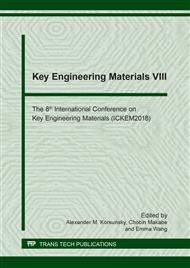p.3
p.7
p.13
p.20
p.26
p.32
p.36
p.43
Mechanical Properties and Phase Morphology of Poly(Lactic Acid)/Acrylonitrile-Butadiene Rubber/Organoclay Nanocomposites Prepared by Melt Blending
Abstract:
This work investigated the mechanical properties and phase morphology of poly(lactic acid) (PLA)/acrylonitrile-butadiene rubber (NBR) blends and nanocomposites, which prepared by melt blending in an internal mixer. The contents of NBR were 5, 10, 15 and 20 wt% and the content of organoclay was 3 phr. The impact test showed that the impact strength of PLA/NBR blends increased with an increase of NBR content and the impact strength of the blends was more than eight times by adding NBR 10 wt% when compared with neat PLA. The tensile test showed that Young’s modulus and tensile strength of PLA/NBR blends and nanocomposites decreased after adding NBR and organoclay. While the strain at break of the NBR blends increased with increasing NBR content. This result is attributed to the rubber phase in NBR in a cause the increment of elongation and elasticity in PLA/NBR blends. The morphology of PLA/NBR blends observed the fractured surface was rougher than that of pure PLA. This observation indicates that the addition of NBR in PLA can change the brittle fracture of PLA to ductile fracture, which has an effect to the strain at break or elongation of PLA. However, the morphology of the PLA/NBR blends were also observed the phase separation of the dispersed NBR phase and PLA matrix phase, and appeared the voids in a polymer matrix. The addition of organoclay had an effect slightly on the morphology of the blends. From X-ray diffraction, results found that PLA/organoclay and PLA/NBR/organoclay nanocomposites showed the intercalated structure, which PLA chains were inserted into the interlayer of clay due to the increase of d-spacing.
Info:
Periodical:
Pages:
13-19
Citation:
Online since:
August 2018
Price:
Сopyright:
© 2018 Trans Tech Publications Ltd. All Rights Reserved
Share:
Citation:


